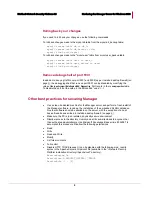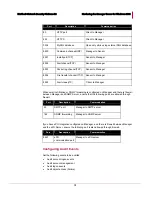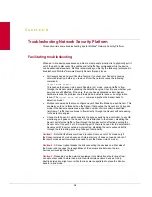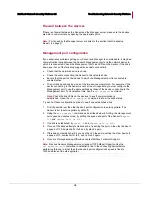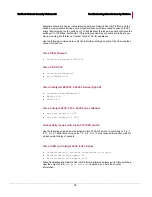
McAfee® Network Security Platform 6.0
Troubleshooting Network Security Platform
21
Counter
Description
Possible Causes
Late Collisions A late collision occurs when two
devices transmit at the same time
and neither side of the connection
detects a collision. The reason for
this occurrence is that the time to
propagate the signal from one end
of the network to another is longer
than the time to put the entire
packet on the network. The two
devices that cause the late collision
never see that the other is sending
until after it puts the entire packet on
the network. Late collisions are
detected by the transmitter after the
first time slot of the 64-byte transmit
time occurs. They are only detected
during transmissions of packets
longer than 64 bytes. Its detection is
exactly the same as it is for a
normal collision; it just happens later
than it does for a normal collision.
This is an indication of faulty hardware (NIC,
cable, or switch port) or a duplex mismatch.
Excessive
Collisions
Excessive collisions are the number
of frames that are dropped after 16
attempts to send the packet resulted
in 16 collisions.
This is an indication of over utilization of the
switch port at half-duplex or duplex mismatch.
Carrier Sense
Carrier sense occurs every time an
Ethernet controller wants to send
data and the counter is incremented
when there is an error in the
process.
This is an indication of faulty hardware (NIC,
cable, or switch port).
Runts
These are frames smaller than 64
bytes with a bad FCS value.
This is an indication of the result of collisions,
duplex mismatch, IEEE 802.1Q (dot1q), or an
Inter-Switch Link Protocol (ISL) configuration
issue.
Giants
These are frames that are greater
than 1518 bytes and have a bad
FCS value.
This is an indication of faulty hardware, dot1q, or
an ISL configuration issue.
Auto-negotiation
Auto-negotiation issues typically do not result in link establishment issues. Instead, auto-
negotiation issues mainly result in a loss of performance. When auto-negotiation leaves
one end of the link in, for example, full-duplex mode and the other in half-duplex (also
known as a duplex mismatch), errors and retransmissions can cause unpredictable
behavior in the network causing performance issues, intermittent connectivity, and loss of
communication. Generally these errors are not fatal-traffic still makes it through-but
locating and fixing them is a time-waster.



